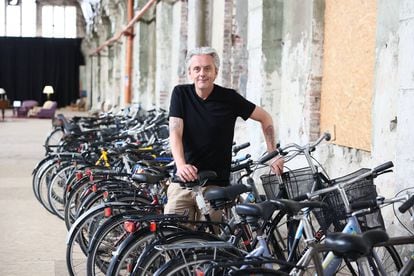Dane Mikael Colville-Andersen (Fort McMurray, Canada, 54 years old) is a true bicycle guru.
His blog
De él Copenhagenize
became a world reference for urban cycling, led him to advise cities that wanted to transform their mobility into a more sustainable one and gave its name to the most recognized classification on
bike-friendly
cities .
After a decade in which he also wrote a book of the same name, he abandoned the project —which continues without him—.
Now, he gives talks around the world on cycling urbanism and films a series on human-sized cities (
The Life-Sized Cities) .
) which can already be seen in 20 countries.
His latest project (Bikes4ukraine.org) has taken him to the Ukraine, where he has donated a hundred bicycles.
"Ukrainians urgently need thousands of bikes," he sums up, back in Copenhagen.
Ask.
Can a bike be used in a war?
Response.
Yes. The activists say: "Use the bike and fuck Putin's gasoline."
Those people really need bikes.
So I have taken bikes to Lviv (to the east), Bucha and Chernihiv, two cities near kyiv that were bombed by the Russians.
I gave bikes to refugees and social workers, who will use them to bring food and medicine to older people in rural areas.
And now I have requests from three other cities that are being bombed.
From Mikolaiv they asked me for 200 bikes, but I don't have them.
I have returned to Copenhagen to try to get them.
Q.
How many bikes did you deliver?
A.
One hundred.
But we could deliver a million bikes and they would use them tomorrow.
It is difficult to get cheap bikes due to supply problems with China.
The first shipment was bikes donated by people in Copenhagen, where there are more bikes than people.
In Denmark we throw away about 400,000 old bikes a year.
In addition, the police remove those that are on the street without use.
So I received a few from the Police and others from an NGO that sends bikes to Africa and with them I filled a van and took it to Ukraine.
And I have founded Bikes4ukraine [bikes for Ukraine] to try to get more.
Q.
Back in Copenhagen, why is this city so bike friendly?
A.
Because we are pragmatic.
All cities were bike-friendly 70 years ago.
Later, Europe copied US traffic engineering and took space away from pedestrians and cyclists.
In Copenhagen there were bike lanes until the 1940s, but from the 1950s to the 1970s they were removed to make room for cars.
The two oil crises of the 70s led us to return to the bike.
And we started to make bike lanes, because pedaling had become dangerous.
In the 90s, the city was close to bankruptcy, and it was another big push to get back on the bike.
At that time we began to measure the cost-benefit of these infrastructures: how much they cost, how many people use them, the public health benefit...
More information
How Copenhagen cornered the car: the bike is the fastest and safest way to get around the city
Q.
Are bike lanes efficient?
R.
In a bike lane, almost 6,000 people can be moved per hour, while in a car lane, a maximum of 1,200.
So bike lanes are the most effective method of moving people in a city.
And we prove it with data, so there is no discussion anymore, not even on the right.
Sometimes the bike lanes seem empty, but that's because they are very efficient: people go by without stopping, there is no traffic jam.
And if you design a good network throughout the city, more and more people will use the bike, because people want to go as fast as possible from A to B.
Q.
Can a city become a cyclist without bike lanes?
A.
No. In cities with more than 70,000 inhabitants with busy main streets, you need cycling infrastructure.
Urban planner and mobility expert Mikael Colville-Andersen, in 2019 during a conference in Berlin.picture alliance (picture alliance via Getty Image)
Q.
What needs to be done to transform cities into more sustainable ones?
A.
End the arrogance of space: we give too much space to the car.
Cars are parked 96% of the time, taking up valuable public space that could be filled by trees or benches.
Even in Copenhagen, 67% of the space is for cars, and in other cities it is much more [In Madrid, Carmena put it at 80%].
The cities have to take away space from the private vehicle and put an end to the transport dictatorship that we have suffered for 70 years.
And redemocratize space.
You have to make cycling the fastest option.
When we ask people in Copenhagen why they cycle, they say it's because it's the fastest way to get around.
Q.
How to convince politicians to build bike lanes?
A.
Voters should force mayors and traffic engineers to ride a bike for a month through their city.
That way they would understand.
In Spain, I think Barcelona and Seville have made some progress, and also some smaller cities, but Madrid is a black hole for cycling in Europe, nothing has changed in 15 years.
Only Prague is doing just as bad.
P.
What will happen to the cities that do not adapt?
R.
Although I design cities for bikes, I am not a cyclist, but someone who moves by bike.
And it is not about bicycles, but about thinking of pleasant cities, with benches, trees, pedestrian streets, little space for the car and a lot of public transport.
Those cities attract.
There is more and more green tourism, people visit Copenhagen because it is like that, it also happens with Ljubljana, which this year is European green capital.
In my TV series I talk about people visiting those more humane cities and moving there.
I don't know why someone would move to Madrid other than because they have a job there.
It's like a museum city from the 50s. Paris is the city to look at: it's incredible, they're building bike lanes and they're going to remove 65,000 parking spaces, and you won't be able to drive to the center if you don't live there.
Every week they announce something surprising, and not only in terms of bikes.
This is how the cities where we like to live are.
And Madrid is not one of them.
Q.
Why did you create
Copenhagenize
?
A.
I did a lot of street photography and one day in November 2006 I photographed a cyclist and put the image on the Internet.
Many people, especially from the United States, began to ask how she could pedal in a skirt, it had a lot of repercussion.
So I started the
Cyclechic blog
[pedaling is elegant].
And then I created Copenhagenize [something like
Copenhagenize
], a blog that became known worldwide.
Then I launched the mobility consultancy, because I understood that in the following years many other cities would want to understand how we had done it in Copenhagen.
And the book of the same name, which I published in 2018 [in English], is a summary of my urban philosophy.
After more than a decade, I left consulting and now I am dedicated to the TV series, which is shown in Belgium, Finland, Denmark...
Colville-Andersen, delivering bikes in the Ukraine in an image courtesy of himself.Mikael Colville-Andersen
Q.
What is cycling urbanism?
A.
Understand how to design a city for bikes: bike lanes, parking lots, bridges... If you apply this bicycle-centric urbanism, the benefits come: less pollution, more health, etc.
If someone rides a bike one kilometer, society earns 23 cents;
if someone drives a car that distance, society loses 87 cents.
The roads are expensive, the cars destroy the asphalt and it has to be changed, they produce pollution, respiratory diseases...
Q.
What role should cargo bikes play?
A.
In Copenhagen there are about 50,000
cargobikes
, most of which are used to take children to school.
It's fun for them, who also get soaked in the bike from a young age and are eager to learn to ride on their own.
Also businesses: carpenters, electricians, plumbers.
It is the most efficient way to carry things and park at the door, without traffic jams.
And now they are seen more and more in other European cities, they are a great option for last-mile delivery of goods.
P.
What would you say to drivers who think that their cities are not for cycling?
A.
Nothing.
In Europe we have anti-tobacco laws, and they would never have been passed if we had asked smokers.
Your opinion is not important.
The same goes for drivers: I don't care what they think, because the important thing is to save lives, improve cities and fight climate change.
You don't have to listen to the drivers.
The cities are ours, not theirs.
And we know how to make them better.
Q.
Why is it important to measure changes well?
A.
Whoever has the most data in a city wins.
If citizens manage to collect the data, politicians may tremble.
And if it's the other way around, it's hard to change things.
Copenhagen has more data than any city in the world: we have sensors on the asphalt and we count bicycle traffic on almost all streets, and also cars, pedestrians... So you know how to better design the city.
And if you make a bike lane, you can know how many cyclists passed before and how many now.
And it is easier to explain it to the citizens.
Data is key in urban planning.
You can follow CLIMA Y MEDIO AMBIENTE on
and
, or sign up here to receive
our weekly newsletter
50% off
Subscribe to continue reading
read without limits
Keep reading
I'm already a subscriber












